Analyzing top posts on my blog during 2015 — Deciding between brand versus readership
- Analysis overview
- Top 10 posts written in 2015
- Top 10 posts of all time
- Top 5 podcasts published during 2015
- General stats
- Other stats
- Analysis
- Confronting reality
- Strategies for brand, or strategies for more readership?
- Other strategies
Analysis overview
Every year I try to analyze the top posts on my site so that I better understand what information people are looking for. This analysis helps direct my blog efforts and lets me know what’s working and not working. This analysis is just as much for me as any reader.
(Compare this 2015 post with the Top 10 posts, podcasts, tweets of 2014 – and what it all means.)
Top 10 posts written in 2015
Based on Google Analytics, these 10 posts written in 2015 received the most traffic:
- My real top 10 technical writing trend predictions for 2015
- Reveal JS: An HTML5 alternative to PowerPoint, with support for SVG graphics
- Swagger tutorial
- Why no one stopped by my technical writing booth at career fair day
- 10 reasons for moving away from DITA
- Newbie to Technical Writer in 4 Easy Steps
- 1.0 Documenting REST APIs
- Swagger tutorial for REST API documentation
- Static site generators start to replace web publishing platforms like WordPress
- API technical writing course on Udemy from Peter Gruenbaum, and some thoughts on documenting JSON
Top 10 posts of all time
These 10 posts received the most traffic overall, regardless of the publication date. All of these posts have publication dates prior to 2014.
- Technical Writing Careers – Answering 13 Questions about Technical Writing Jobs
- Quick Reference Guides
- Quick Reference Guides: Short and Sweet Documentation
- JavaScript: Events and Listeners
- Top 10 Most Frequently Asked Questions about Technical Writing
- Seamlessly Integrating a Blog into Your Non-Blog Website
- How to Create Video Tutorials – A Five Step Process
- Avoiding plosives and breathing noises (Voiceover)
- Are Certificate Programs Helpful for Transitioning into Technical Writing? [Collaborative Post]
- Sample Expand and Collapse Code with Twisting Buttons
Top 5 podcasts published during 2015
The following podcasts published during 2015 received the most downloads:
- The divide between academics and practitioners — Interview with Lisa Meloncon (804 downloads)
- Spec-driven Development of REST APIs, with a focus on RAML — interview with Michael Stowe (753 downloads)
- Recording of Innovation in Technical Communication keynote at tcworld India 2015 (657 downloads)
- How do design, length, and relevance affect how people use API reference docs — interview with Bob Watson (617 downloads)
- Recording of API documentation workshop (REST and Javadoc) at tcworld India 2015 (594 downloads)
General stats
Here are some general stats from Google Analytics around my blog. The duration is the 2015 year (Jan 1 to Dec 31).
- Sessions: 376,461
- Pages per session: 1.66
- Average session duration: 1:37
- Page views: 624,964
- Bounce rate: 781.8
- New sessions: 74.44
The stats are not too different from last year. This chart compares 2015 with 2014.
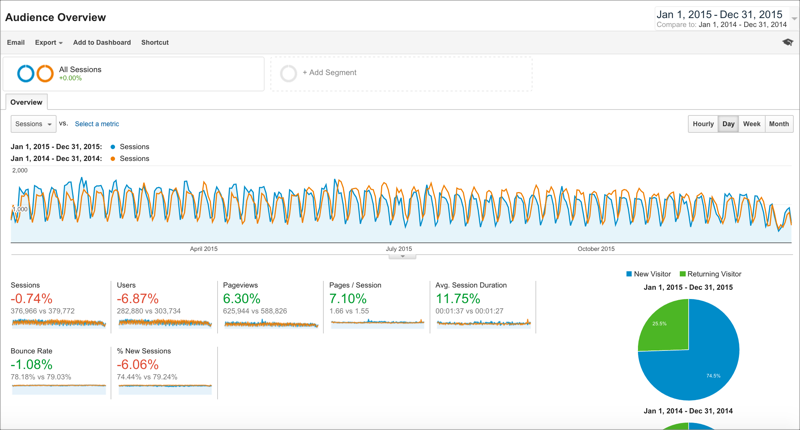
The number of sessions are relatively the same, but the pageviews, pages per session, and average session duration increased in noticeable ways.
Other stats
Google Analytics has a host of analytical data about my visitors. Here’s a smattering of various facts:
- 45% of users are from the US, 11% from India
- 53% are using Chrome, 12% using IE
- 62% use Windows, 16% use Mac
- 8% are iOS, 7% are Android
- Based on Google’s “interests” category, 7% are technophiles, 5% are TV lovers, 4% are new junkies and avid readers, 5% are interested in employment, 3% are interested in software
- 75% are new visitors, 25% are returning visitors
- 82% of visitors are desktop, 14% mobile, 4% tablet
Here’s the statistic that always blows my mind:
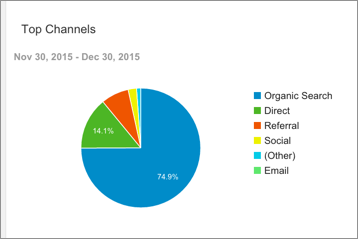
In other words, here’s how people arrive at my blog:
- Organic search: 267,951 (71%)
- Direct links: 61,292 (16%)
- Referrals: 29,877 (8%)
- Social media: 12, 218 (12%)
- Other: 5,00 (1%)
Of the 71% search traffic, 67% of visitors comes from Google. Only 6% of traffic comes from my newsletter, 10% from Twitter, 7% from Disqus.
From Google Webmaster Tools, here are some common search terms:
- swagger tutorial
- technical writer interview questions
- swagger api tutorial
- javascript event listener
- quick reference guide template
- jekyll documentation theme
- technical writing certification
- quick reference guide
- technical writing certificate
- technical writing tips
- technical writer salary
- technical writer resume
- technical writing books
- principles of technical writing
- technical writing skills
- how to create video tutorials
- technical writing career
- javascript listener
- how to make video tutorials
- software tools for technical writing
- jekyll incremental build
I have 2,212 URLs submitted in my sitemap, and 2,154 URLs indexed. (I’m not sure why some aren’t indexed…)
Google says the average page loading time is 7.16 seconds.
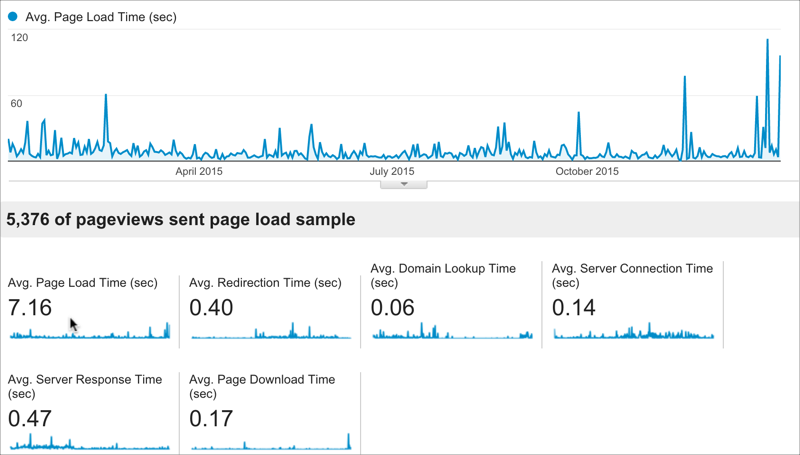
I honestly don’t know how to interpret this statistic. Pingdom Tools puts my average page load time much quicker. You can see when I switched from WordPress to Jekyll, the page loading time dropped from about 2 seconds to 0.2 seconds.
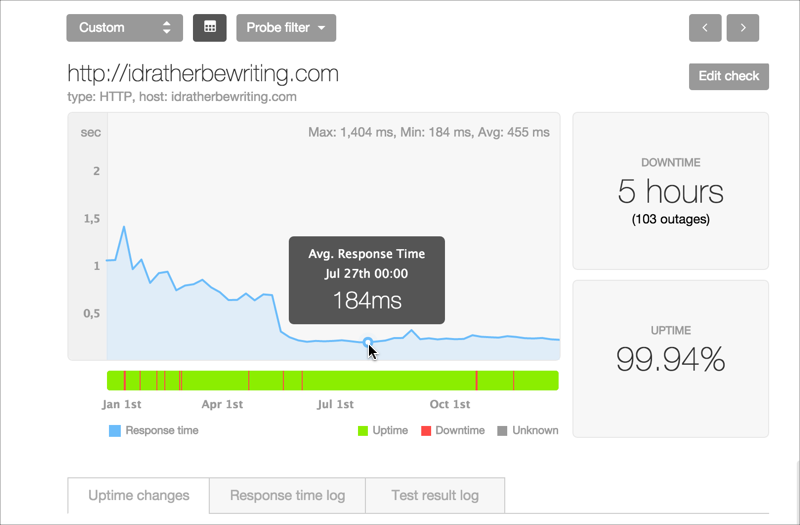
Analysis
I was particularly curious about the statistics this year because I switched from WordPress to Jekyll. I’m glad that my site stats didn’t drop due to the new platform. I hoped Jekyll’s quick loading time would result in more sessions and page views, and those stats did improve a bit.
I still need to do some other cleanup from the migration to Jekyll, by the way. I spent a long time fixing some formatting this year. For example, I spent days just removing WordPress’s custom [caption] tags on images.
This made me think twice about ever including non-standard HTML in posts. Some formatting tasks still remain. For example, when I was on WordPress, I used the auto-embed function for Youtube URLs. I need to go through all my posts and add the full embed code for those Youtube URLs.
Confronting reality
Whenever I look at my stats, I always want to deny the most staggering, mind-blowing facts. But here’s the truth. 75% of my visitors are new and coming from Google. Social media accounts for only a small percentage of my traffic. Based on this, I should be writing for search engines and targeting keywords in my blog posts. The time of day and length of my posts doesn’t much matter. What matters is how my site surfaces and appears in Google’s search engine.
A lot of my visitors are new to technical writing. They’re searching for information on technical writing certification programs, jobs, salaries, skills, and other details associated with technical writing careers. In other words, most of my traffic is from newbies trying to learn about technical writing. Is that what I should focus on?
Last year there was also a lot of traffic with my API documentation writing course and Swagger tutorial. But by and large the main audience for my blog is the unsubscribed user who lands on the site, glances at a page, and then bounces off. I am doing a poor job at converting those users into regular email subscribers. Of the 1,030 average sessions per day, it seems like only about 5 actually subscribe.
The regular users who comment on my blog don’t represent the overwhelming traffic from organic search. It’s easy to overlook that and just think of my regular commenters as my readers. But those who comment are in the minority by far. The bulk of my visitors are like the dark matter of the Internet — present and undeniable but ethereal and unknown. Who the heck are all the users from the other sessions? How can I convert them into regular subscribers?
Last year I also started using Bit.ly to track hits on posts. Looking at Bitly, it was pretty clear that sending out links in an email newsletter is a major strategy for driving traffic to the posts. If you just submit the links to Twitter and Linkedin, you only get a tenth of the traffic that you do from sending out the links via an email newsletter.
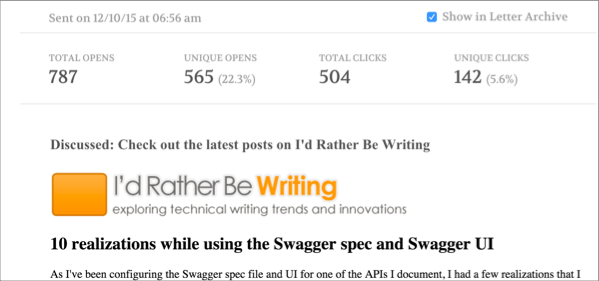
But then again, most traffic originates from organic Google searches rather than social media anyway.
Strategies for brand, or strategies for more readership?
If I wanted to increase the readership of my blog, here’s what I should do:
- Write SEO-rich posts targeted at Google search
- Focus posts on tips for new or transitioning technical writers
- Convert more visitors into email subscribers
This year I’m thinking of adding a new course on my site called “Getting started with technical writing” or something, and then covering a host of newbie topics. I’m not sure if a focus on the basics will motivate me to write, though. I tend to write about topics and ideas that I’m thinking about or experiencing, and I’m not sure if I can write passionately about technical writing certificates, technical writing tips, technical writer salaries, technical writer resumes, and technical writing books. But I just might give it a try.
The downside of focusing on these mainstream, general topics is that it will dilute my sense of expertise or brand. This past year I wrote a lot about API documentation. These posts helped present me as an expert in API documentation.
The secret trick to online branding is that simply writing extensively and thoughtfully about any topic will brand you as an expert about that topic. Robert Scoble recommends that you blog only about what you want to be known for, or the direction you hope to go. For example, if you want to drive cabs, let cabs be the dominant focus on your blog:
If you want to drive a cab, you better go out and take pictures of cabs. Think about cabs. Put suggestions for cabbies up. Interview cabbies. You better have a blog that is nothing but cabs. Cabs. Cabs. Cabs all the time. (See If you are laid off, here’s how to socially network)
I both have a passion for API documentation and want to brand myself as an API documentation expert, so I blog a lot about API documentation. After some months, I was asked to teach numerous workshops on API documentation.
However, most of my blog traffic, the 75% of my sessions, are more focused around newbie technical writing topics. New or transitioning technical writers usually aren’t looking for information on API documentation. Even most of my existing subscribers probably aren’t that interested in API documentation. Writing so extensively about API documentation alienates me from mainstream readership, but it also helps brand me as an API documentation expert.
As I said before, if you want to brand yourself as an expert in a topic, you have to write a lot about that topic. But sometimes that expert-branding focus won’t lead to the most readership. As a result, you have to consider what goals are more important for you — expert branding, or readership? Do I want to be known as an “API documentation expert,” or do I want to triple my readership?
More readers means more potential advertising revenue, but a stronger brand focus means potentially better job offers, more consulting, and more opportunities related to that brand expertise.
Maybe as a compromise I could alternate between the two topics?
Most likely I’ll continue the same path as before, emphasizing brand and API documentation specialization. But occasionally I’ll thrown in some general information for new and transitioning technical writers.
Other strategies
Another strategy I have is to convert one of my series (such as the one on getting a job in technical writing) into a free downloadable “ebook” as an incentive for people to subscribe. I think this will help convert visitors into subscribers.
Finally, I need to stop focusing so much on social media promotion and think more strategically about keywords on Google (regardless of my blog’s focus). Links on social media channels evaporate within a day of posting, but URLs indexed by Google are more permanent and visible.
About Tom Johnson

I'm an API technical writer based in the Seattle area. On this blog, I write about topics related to technical writing and communication — such as software documentation, API documentation, AI, information architecture, content strategy, writing processes, plain language, tech comm careers, and more. Check out my API documentation course if you're looking for more info about documenting APIs. Or see my posts on AI and AI course section for more on the latest in AI and tech comm.
If you're a technical writer and want to keep on top of the latest trends in the tech comm, be sure to subscribe to email updates below. You can also learn more about me or contact me. Finally, note that the opinions I express on my blog are my own points of view, not that of my employer.
